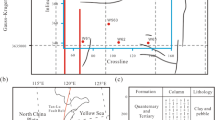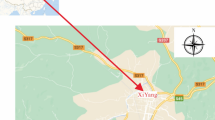Abstract
The longwall mining method has been widely used in underground mining of coal seams. For longwall mining, the stability of coal-seam roofs and hardness of coal rocks in coal-bearing strata are particularly important. High-precision multi-component seismic exploration technology can obtain more parameters for characterizing coalbed reservoirs than conventional methods, and it is gradually replacing conventional P-wave technology in coalfield exploration. We have obtained multi-component seismic data from the central mining area of Guqiao Coal Mine, in the Huainan area, China. Using constraints from logging information, and seismic data, joint PP- and PS-wave inversion and interpretation have been performed. The coal seam 13-1, located in a Permian formation, was studied to determine the lithology of the coal-seam roof and floor, evaluate the stability of the coal-seam roof, and determine the hardness of coal rocks in coal seam 13-1. The distribution characteristics of lithology, roof stability, and hardness of coal rocks in coal seam 13-1 were also investigated. To achieve this, we used P- to S-wave velocity ratios to identify the lithology, evaluated the roof stability with parameters LambdaRho and MuRho, and used Young’s modulus to evaluate the hardness of the coal rocks. Our predicted results are in good agreement with the interpretative results from logging information, which shows the accuracy of our method. The joint PP- and PS-wave inversion and interpretation used in this paper can obtain more accurate information for evaluating coalbed reservoirs than conventional methods, which are valuable in assessing mine safety.













Similar content being viewed by others
References
Aki K, Richards PG (2002) Quantitative seismology, 2nd edn: W.H. Freeman and company, San Francisco, California
Brick GA (2004) Iowa underground: a guide to the state's subterranean treasures. Trails Books, Black Earth, pp 119–120
Calderon J, Ovalles A, Reveron J (2013) Lithology discrimination using 3D3C seismic data in the Faja Petrolifera del Orinoco, Venezuela. 75th EAGE Conference & Exhibition Incorporating SPE EUROPEC
Castagna JP, Batzle ML, Eastwood RL (1985) Relationship between compressional-wave and shear-wave velocities in clastic silicate rocks. Geophysics 50:571–581
Chen XP, Huo Q, Lin J, Wang Y, Sun F, Li W et al (2014) Theory of CBM AVO: I. Characteristics of anomaly and why it is so. Geophysics 79(2):55–D65
Einicke GA, Ralston JC, Hargrave CO, Reid DC, Hainsworth DW (2008) Longwall mining automation. An application of minimum-variance smoothing. IEEE Control Syst Mag 28(6):28–37
Engelmark F (2012) Using 4-C to characterize lithologies and fluids in clastic reservoirs. Lead Edge 20(9):1053–1055
Fatti JL, Smith GC, Vail PJ, Strauss PJ, Levitt PR (1994) Detection of gas in sandstone reservoirs using AVO analysis: a 3D seismic case history using the Geostack technique. Geophysics 59:1362–1376
Gil AP, Flores GP, Ovalles A, Villar I (2014) Lithological estimation with V p / V s ratio from 3D3C seismic in unconsolidated sands at Orinoco oil belt, Venezuela. 76th EAGE conference and exhibition
Gochioco LM (2012) Seismic surveys for coal exploration and mine planning. Lead Edge 9(4):25–28
Gochioco LM, Gochioco JR, Ruev F (2012) Coal geophysics expands with growing global demands for mine safety and productivity. Lead Edge 31(3):308–314
Goodway B, Chen T, Downton J (1997) Improved AVO fluid detection and lithology discrimination using lamé petrophysical parameters; “λρ”,“μρ”,&“λ / μ fluid stack”, from P and S inversions. SEG Technical Program Expanded Abstracts 16(1): 2067
Greenhalgh SA, Emerson DW, Greenhalgh SA, Emerson DW (1986) Elastic properties of coal measure rocks from the Sydney basin, New South Wales. Explor Geophys 17(3):157–163
Hampson DP, Russell BH, Bankhead B (2005) Simultaneous inversion of pre-stack seismic data. SEG Technical Program Expanded Abstracts, 1633–1637
Hou G (1997) Truss support nursing and its applications. China University of Mining, Beijing
Larsen JA (1999) AVO inversion by simultaneous P-P and P-S inversion: M.S. thesis, University of Calgary
Li J, Pan D, Cui R, Ding E, Zhang W, Hu M (2016) Prediction of tectonically deformed coal based on lithologic seismic information. J Geophys Eng 13(1):116–122
Lu J, Meng X, Wang Y, Yang Z (2016) Prediction of coal seam details and mining safety using multi-component seismic data: a case history from China. Geophysics 81(5):B149–B165
Lu J, Wang Y, Chen JY, An Y (2017) Joint anisotropic AVO inversion of PP and PS seismic data. Geophysics 83(2):1–83
Luo D, Sun S, Zhang D, Wan Y, Zhang G, Niu J (2011) Application of improved EAHP on stability evaluation of coal seam roof. IEEE, International Conference on Computing, Control and Industrial Engineering 2:417–420
Paridon HV, Fallon G (2001) Estimating coal quality from seismic data -is it possible? A case study from the Bowen Basin. Aseg Extended Abstracts 2001(1):1
Tang H (2011) Seismic prospecting technique for coalbed methane accumulating area. Procedia Earth & Planetary Science 3:224–230
Wang H, Gu G, Lu D (2012) Coal seam roof stability prediction and evaluation based on GIS platform with multiple data sets. ASEG Extended Abstracts 2012(1):1
Wu H, Dong S, Huang Y, Chen G, Wang H (2015) A method for coal structure division based on AVO simultaneous inversion. J Seism Explor 4:365–378
Zhou B, Hatherly P (2000) Pushing coal seismic to its limits through computer aided interpretation and 3D seismics. Explor Geophys 31(2):343–346
Acknowledgments
We gratefully thank Huainan Mining Group for providing us the research data.
Funding
This research was supported by the National Natural Science Foundation of China (Nos. 41574126, 41425017) and the Fundamental Research Funds for the Central Universities (No. 2-9-2017-452).
Author information
Authors and Affiliations
Corresponding author
Rights and permissions
About this article
Cite this article
Xiong, S., Lu, J. & Qin, Y. Prediction of coal-bearing strata characteristics using multi-component seismic data—a case study of Guqiao coalmine in China. Arab J Geosci 11, 408 (2018). https://doi.org/10.1007/s12517-018-3767-0
Received:
Accepted:
Published:
DOI: https://doi.org/10.1007/s12517-018-3767-0




